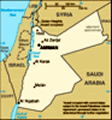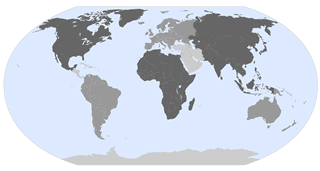Advertisement
Published: April 17th 2008
After five days at sea we entered the Gulf of Aqaba and docked in Jordan’s only seaport, Aqaba. We were here two years ago and visited one of the most amazing places on earth. Petra is the rose colored wonder of the world. To get an idea of what Petra is like, it would be helpful to imagine the Grand Canyon with a whole city carved into its steep walls complete with amphitheater, houses, tombs, public baths and latrines. Then add camels, donkeys, horse carts and Bedouin merchants and you have the picture of what Petra is like. Many moviegoers have actually seen parts of Petra in the Harrison Ford film, Indiana Jones and the Last Crusade. But probably its more famous visitor was Moses, where he struck a rock and water poured forth. Petra became the capital of Nabatean Kingdom centuries before Christ was born. It was an important center of the world spice trade and at its height of prosperity, Petra was home to around 30,000 Arabians. The thirteen story high Pharaoh’s Treasury building is probably one of the most famous archeological ruins in the world. The 10,000 seat amphitheater is evidence of the Roman annexation of this area
around the 1st century AD. While all of the manmade structures are certainly awe inspiring, it was the colors of the stone that struck me. The red, purple, blue and yellow striations look like they were painted on the face of the cliffs by Dali.
Speaking of Moses, it was ironic that we happened to be cruising in the Red Sea, when we heard of the passing of Charleton Heston-- the Moses of Hollywood.
This trip we decided to explore the port city of Aqaba. It is said to house the oldest church in the world. Because of its strategic location, it was also an integral stop along the Spice Route connecting Asia, Africa and Europe. Reportedly, King Salomon and the Queen of Sheba hung around these parts in the 10th Century BC—building ships and holding court.
We went to the small museum in Aqaba which houses archeological treasures from the area. But other than that, not much money has been invested in touristic infrastructure in Aqaba. The town itself is a pretty dilapidated place where mud brick structures house the residents. Although we did note that even the lowliest hovel had a satellite dish attached to
its roof. Even in the market area, many of the streets are made up of broken cement or rutted dirt roads. An Arab woman with two small children approached Kevin to comment on our Croc shoes. This was the first time I have ever seen a Muslim woman talk to a western man, as, generally it is forbidden in most of these countries for a woman to talk or associate with any male who is not related. It turned out that she teaches English and that is perhaps what gave her the courage to speak to a stranger. We saw skinned goats hanging in the market stalls ready for sale and the orange fruit stalls were the only bit of color in this dusty town. We walked the Corniche road back to the port. Along the way we visited the Mamluk Fort and watched the locals swimming in the polluted water. A woman completely covered in veil and robe was wading in the murky water. There is much security in evidence and a few too many machine guns for my taste. Israel is a mere three miles across the Gulf of Aqaba. Eilat is a thriving resort which attracts residents
from the more troubled northern areas of Israel. We would have liked to visit Eilat but were told it was not possible since we didn’t have an Israeli visa.
We celebrated our wedding anniversary with a quiet dinner on our balcony watching the sun set over Israel and contemplated the journey we have been on since that morning in Kingsland, Georgia when we pledged our love and commitment to each other. Thirty five years ago, who ever could have predicted that we would mark an anniversary in the biblical town of Aqaba, Jordan?
We had a lovely sail around the Sinai Peninsula, past one of our favorite ports, Sharm el- Sheik and arrived at the entrance to the Suez Canal at 4am. It took five hours and numerous cartons of cigarettes to finally get the clearance from local authorities to enter the canal. We were the second to the last ship of a 37 boat convoy heading up this lockless ditch in the desert. This was our fifth trip through the canal and it is quite a different experience from the Panama Canal. While some palm trees are in evidence on the western side of the canal, the
Sinai Desert on the right is starkly barren except for the war debris left from the many Israel/Egyptian conflicts. Both sides of the waterway are lined with armed troops and lookout towers. We visited the ship’s bridge during our transit and noticed that the Queen Victoria and Costa Romantica were leading the convoy through the canal. After a short stop in Port Said and many more cartons of cigarettes paid to smooth our way, we left the Suez and sailed into the Mediterranean Sea. The Captain calls the Suez Canal “Marlboro Country”-- with good reason.
We spent our last day in Arabia in the historic city of Alexandria. Founded by Alexander the Great and home to Cleopatra, this port city once had the tallest building on earth. The Pharos Lighthouse of Alexandria was considered one of the Seven Wonders of the Ancient World, not just for its height but for it unique mirror whose reflection could be seen up to 50 miles away. This helped to guide sailors safely to port for centuries, until the whole building was destroyed by an earthquake. Perhaps Alexandria most famous edifice was its ancient library which was one of the largest repositories of
the written word in the world. It too was destroyed by fire. Julius Caesar, when not pursuing Cleopatra, drew up the Julian calendar which is the basis for calculating our months, weeks and days. As the gateway to the Middle East, Alexandria was considered the most cosmopolitan of all cities in the Mediterranean during the 18th and 19th Centuries. Between earthquakes, fires and world wars, there is little evidence left of this sophisticated metropolis now.
We hired a taxi and went in search of the old and new Alexandria. Bibliotheca Alexandrina is the modern day replacement of the ancient great library. The lines were too long to try to get in, so we just admired the glass and granite exterior of the building. There are catacombs and a theater reflecting the Roman influence. We drove to Fort Qayt Bay which was built over the ruins of the lighthouse. We took in the fish market, the Abu el-Abbas Mosque and some of the back streets. It seemed that our driver knew everyone in town. He stopped and waved and chatted continuously with his buddies until we reminded him that we were paying him by the hour to see the town
and not his circle of friends. We spent a lot of time stuck in a horn-honking traffic maze. So after a nice fish lunch overlooking the Eastern Harbor we hoofed it along the Corniche to the Cecil Hotel, with its belle époque era designed wrought iron elevator and roof top restaurant. This Chinese eatery is where we had our Easter dinner last year. That night as we sailed away, we met up with Len and Mimi for dinner. We all dressed up in our Egyptian finery and bade farewell to the Middle East.
After almost two weeks in Arabia, we woke to find ourselves approaching the beautiful walled city of Rhodes Town on the island of Rodos, Greece. The tremendous social differences we saw within twenty four hours was the closest thing to culture shock that can be experienced in this media filled world. As much as we are intrigued by traveling through Arabia—it is with a sense of relief to reenter a more familiar part of the world. Our day in Rhodes was wonderful—there was color and light and people enjoying themselves and women out in public. The stark desert landscape of the Middle East versus the lush
Mediterranean islands reflects the contrast of the Muslim world with the western way of life. While there are extremes and moderates in both societies, I find myself more comfortable in the secular world of the west. We just read that Islam has become the dominant religion in the world. We can only hope that these two different worlds will learn to be more tolerant and understanding of each other’s values and way of life.
Since Greece is now part of the EU, the days of cheap travel in this country are over. It took some hard bargaining in Rhodes to get a taxi for an hour for less than $40. Granted, the taxi was a new Mercedes and the driver was as knowledgeable as any tour guide we’ve had. Yannis decided to call Kevin “Mr America” and he kept telling us how rich everyone is in the United States. We told him that he wasn’t doing too bad, having a fancy Mercedes, only working half a year and having the strong Euro. Plus life on this island is quite idyllic.
We visited the old walled city on foot and it is a masterpiece of medieval buildings, churches and
ramparts. Rhodes was the main supply stop on the road to the Holy Land by the Crusaders. It is a World Heritage site restored and protected for future generations who will be able to marvel at the skills and financial acumen of the Knights of St John who supervised and paid for these beautiful edifices.
The Mediterranean tourist season has not yet kicked into high gear and since we were the only ship docked in this popular port, it was like we were touring in our own personal theme park. We explored the backstreets and towers and churches and mosques without the crowds. The merchants were happy to see us as were the restaurateurs. We sailed away just as the sun was setting on this medieval masterpiece.
That night we heard the wonderful news that the crew of the hijacked French ship had been freed. What a relief! Six of the crew members on LePonant were Filipinos and so the crew on our ship was quite concerned about their fate. All seafarers share a common bond and wish for only the best for their compatriots. There was probably much rejoicing in the crew quarters that night. It was
even better news that a number of the hijackers were captured. They have been creating havoc in this part of the world for years and present a definite threat to all the ships that travel in these waters. We are happy that there are a few less pirates on the high seas.
Advertisement
Tot: 0.051s; Tpl: 0.013s; cc: 8; qc: 24; dbt: 0.0298s; 1; m:domysql w:travelblog (10.17.0.13); sld: 1;
; mem: 1.1mb





















Janice Bostock
non-member comment
Great job!
Hi Susan and Kevin, What a fabulous chronicle you are doing of your trip. Your knowledge of history combined with your sense of humour, makes for a fascinating read. You must publish this when you get home. John and I are both really enjoying each episode. Thanks, Janice